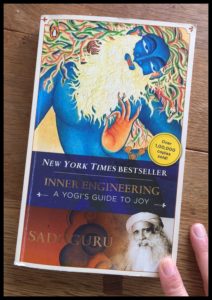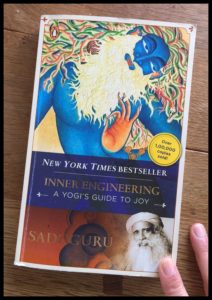Book Review and Recommendation

Inner Engineering: A Yogi’s Guide to Joy,
by Sadhguru
I first heard of Sadhguru a few years ago when, looking for inspiring music for my own practice, I stumbled upon a mesmerizing chant of his called “Brahmananda Swarupa.” Immediately, this mans powerful, ethereal voice resonated with something deep inside me and intrigued, I began to research a bit about him.
Finding information on Sadhguru is not hard to do. The self-proclaimed mystic and world renowned yogi has a very strong, smooth presence online… which in some ways seems a strange juxtaposition against such staunch spiritual teachings by a realized yogi. But this being the 21st century, Sadhguru uses modern technology to his advantage in order to reach the masses, with the intention of giving us his particular slant on the ancient teachings of yoga… and he uses these mediums well.
 Whether audio, video, or written word, I found his intrigue to be immediate. Like many appealing speakers, he peppers his teachings with humor… a particularly helpful tool when confronting the ominous task of walking the spiritual path toward one’s higher self. His sense of levity tangibly lightens a load which can often feel like a burden to those who take the task seriously. But more importantly, Sadhguru understands that in order to bring the benefits of these ancient esoteric teachings to the modern world, you must make the teachings relevant to modern day life. And this, is why I loved the book so much.
Whether audio, video, or written word, I found his intrigue to be immediate. Like many appealing speakers, he peppers his teachings with humor… a particularly helpful tool when confronting the ominous task of walking the spiritual path toward one’s higher self. His sense of levity tangibly lightens a load which can often feel like a burden to those who take the task seriously. But more importantly, Sadhguru understands that in order to bring the benefits of these ancient esoteric teachings to the modern world, you must make the teachings relevant to modern day life. And this, is why I loved the book so much.
Inner Engineering, I have discovered, is not just a book about yoga, but rather, the book itself is an introduction to Sadhguru’s brand of approaching the teachings of yoga. Inner Engineering is his particular recipe for a happy, healthy life using the ample ingredients that make up the practice of yoga. And to be clear, we’re not talking about the sweaty 60 minutes on a sticky mat kind of yoga, but the application of using our heart and our mind along with our inherent desire to evolve as a spiritual being kind of yoga. And this book, whether you have any intention of taking your knowledge or application of yoga beyond the mat or not, serves as an informative and inspiring stand-alone introduction to the deeper aspects of this ancient practice… and how those applications can help you find the happiness that is your birthright as a human being.
“The foundations of peace and bliss are not about attending to the external realities of your life, but in accessing and organizing the inner nature of your being.”
Inner Engineering gives an extremely comprehensive overview of the science of yoga. For the well versed yogi it is unlikely that you will learn any new “facts”, but for me, I did find a new and beautifully simple perspective on how to approach these teachings on a personal level, and that was like a breath of fresh air. Reading his book, you realize this kind of meaningful simplicity is Sadhguru’s forte. This is an imperative part of his appeal.
He begins the book right away by telling us one of the most profound truths about yoga: It is to be learned and understood on an experiential level. Period. “The whole process of yoga is to take you, step by step, and stage by stage, from the known into the unknown. It is one hundred percent an empirical science. It does not ask you to take anything on trust. It urges you to experiment every step of the way.” He does not give us any doctrine or ask us to believe in the science because he is the guru and knows better. He gives us common sense and asks us to experiment with it ourselves.
He then goes on to break down the science of yoga itself. To be clear, this is not modern day science, although throughout the last several decades we are finally starting to see some validation of yogic science though modern means. He takes esoteric concepts such as “reality” and “consciousness” and strips them down to fundamental basics in a way that simply makes sense. And to me, this is the sign of a true teacher…. someone who can bring simplicity to overwhelmingly grand concepts. Having studied the yogic science on a fairly deep level myself, I have always found it to be logical at its core, but it can undoubtedly be a bit esoteric and a lot to unpack, so I appreciated the frank and concise way he presents what it is to be human. No easy task.
He continues then, to give us a comprehensive understanding on how to approach working with the three layers of our being that we are familiar with… our bodies, our minds and our energy. (In the yogic science there are five layers to our being, which he mentions for informational reasons, but does not go into, specifically so as to avoid getting too esoteric and making the entire thing feel un-relatable.) These sections of the book dive deep into what we are made of on a physical, mental and energetic level, bringing the yogic perspective and the real-world human perspective together in an entirely sensible way.
I think it is safe to say that for anyone with an interest in yoga or anyone who is looking for deeper understanding of the self, this book is a very palatable and easy way to understand what exactly it is we’re trying to do here… not here on the yoga mat, but here on this planet, here in this human incarnation. The science of yoga, when delving deep, can feel esoteric and all too theoretical. His words restructure these teachings in a way that everyone can understand. But above all, his words inspire something greater inside of us to grow upward and outward, and in today’s world, that might be the biggest gift of all.
“The entire yogic process is aimed at aligning oneself with the natural longing of life to expand in an unlimited way. It gives conscious expression to this basic human need.”
For those of us on the “spiritual path” or, the path of inner evolution, there are moments, sometimes many of them, where one feels they have encountered a wall they can neither go over, under, nor around… and generally, that is not a very comfortable feeling. On a personal level I have felt the heaviness of this blockage more times than I can recount, and I am happy to say I found this book, filled with simplicity, logic and levity, to be a delightful panacea, creating space to move forward with renewed vigor.
Now I must interject that, despite my affinity for Sadhguru’s teachings, which are very much in alignment with the traditional teachings of yoga that I follow, I have always had a hard time around the “super-guru” such as he is. His following is immense and he takes his teachings to thousands around the world, and while I am someone that applies a fair amount of common sense to my world view… ie, if he’s so popular it must be with very good reason… I’m also a pretty big skeptic when it comes to following the masses. The “sheep” mentality is real, and in an endeavor to find our true selves, we must learn to perpetually discern whether our own opinion is separate from or in alignment with that of the majority. Sometimes the mere desire to be part of the majority can cloud that lens.
There is also the question of the commercialization of something so sacred. One cannot help but look at all of Sadhguru’s media without feeling a tiny bit like you’re being sold something… which in fact, you are: your own growth. But for better or worse, the business of spirituality is just like every other business around… it involves the give and take of product or knowledge for something in return… usually money. For every sincere teacher, there are many who are there only to exploit the vulnerable seeker. Sadly, there have been far too many instances over the years in the yoga/spiritual/religious world where unethical behavior by the guru/teacher/leader tainted the industry on a whole. Spiritual leaders from every sect, who surely started their path with best of intentions, have been led astray by the beguiling allure that power and money bring with them. So in this regard, I approach and have always approached any “big names,” particularly where there is a “product” to be sold, with a healthy dose of skepticism.
Be that as it may, Sadhguru has a huge presence around the globe and looking through his website you begin to understand that his nonprofit organization, The Isha Foundation, has made a positive impact worldwide. Aside from the retreats and courses he offers, the foundation gives back to the community in a number of important ways… educating the underprivileged, spear-heading environmental and social causes etc. After all, there is strength in numbers, and a community of like-minded people has always had the ability to make a bigger impact than the individual can alone. This, I understand, is part of the allure in being part of a collective, and why it appeals to so many people.
And so on the heels of this inspiring read and in my ever present need to follow the basic tenet of yoga: experiential understanding, along with some serendipitous nudging by the Universe, it turns out I will be spending five days at his ashram in April.
Leaving space for an opportunity to present itself, I had five unscheduled days at the beginning of my upcoming trip to India, and when I curiously looked into what was happening at his ashram in India during that time, I saw there was an Inner Engineering Retreat happening during those exact dates. To me, the invitation couldn’t have been any clearer. While I have taken part in countless classes and retreats with an incredibly diverse spectrum of teachers over the years, this kind of large, big-name ashram environment will be a first for me. And so this visit not only fits in perfectly with my timing, but with my desire to explore as many different experiences as possible. Even (or especially) the ones for which I find a healthy dose of both reservation and intrigue.
In closing:
My grade on Inner Engineering, the book: A+
My grade on Inner Engineering, the practice: TBD
Stay tuned…
Namaste,
Barbara


